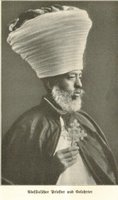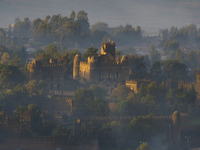 The book Ethiopian National Flag attempts to document the origin of the Ethiopian National Banner from all angles. The author, Asfaw Tefera, in 1999, has surgically examined the folklore, legends and documented accounts of the Ethiopian Flag or Sendek Alama. He was able to discover that at various times the Ethiopian flag was either blue or contained two white stripes and many more variations of the Green Yellow and Red. The interpretations of the flags are also discussed. Unfortunately, there is a tendency to discount the Ethiopian legend as he attempts to discover the origins of the Ethiopian National Flag. is by strongly relying on documents. Basically there is an attempt to describe the legend as nothing more than myth since Ethiopians are well known to rely on legends than on documentations.
The book Ethiopian National Flag attempts to document the origin of the Ethiopian National Banner from all angles. The author, Asfaw Tefera, in 1999, has surgically examined the folklore, legends and documented accounts of the Ethiopian Flag or Sendek Alama. He was able to discover that at various times the Ethiopian flag was either blue or contained two white stripes and many more variations of the Green Yellow and Red. The interpretations of the flags are also discussed. Unfortunately, there is a tendency to discount the Ethiopian legend as he attempts to discover the origins of the Ethiopian National Flag. is by strongly relying on documents. Basically there is an attempt to describe the legend as nothing more than myth since Ethiopians are well known to rely on legends than on documentations.

In this section, we shall attempt to reveal the mysterious origin and interpretation of the Ethiopian flag which has been passed down as folk lore through oral history. The Ethiopians call their flag Sendek Alama, which literally means "Sceptre Motto " or "Sceptre Symbol" or "National Flag". The Ethiopians also use the bastardized name Bandira (Italian=Bandiera), unaware that it is of Italian derivative for banner or flag. We believe that the Ethiopian flag of Green Yellow and Red is the oldest flag in the world and are presenting the wonderful and majestic story here.The earliest flag used by humankind is probably the colors of the rainbow (Keste Damena or Bow of the Cloud), basically the Green Yellow and Red. Two nations that have kept these cultures are Ethiopia and Bolivia. Today Bolivian Indians still use the colors to celebrate some of their festivals but in Ethiopia it is still the emblem of the country. Throughout the year, it is seen in the rains of the monsoon seasons or in one of the many waterfalls (Fwafwate) during the dry season, as a reminder that God made to man never to destroy the earth with water. The right photo above show the rainbow after a shower in Yayi, Ethiopia. The left photo is the perpetual rainbow at the Blue Nile falls (Tis Isat or Smoke of Fire). The flag has an ancient roots and therefore has many interpretations. The flag colors signifies such doctrines as Faith Hope and Charity, Father Son and Holy Spirit and Wealth Blood and Fertile Land. Ethiopians however believe it was given to them by God and its sanctity is beheld. (Photo from Pankhurst, Ethiopia).
 The image of the flag with the Lion of Judah (Moa Anbessa) is from a flag used in the Jubilee Palace and depicts the official and correct Lion of Judah symbol. Certain individuals use the British or Persian lion but the Lion of Ethiopia is unique and as depicted on the currency of the country. Tourists and pseudo-scholars sometimes provide wrong information that are picked up by the lay person just because it was written by a European. One such example is Herbert Vivian, a British traveler who was in Ethiopia in 1900 and who describes the flag of Ethiopia in his book Abyssinia as White Red White horizontal strips when he first saw it near Somadu and Gildessa close to Harar.
The image of the flag with the Lion of Judah (Moa Anbessa) is from a flag used in the Jubilee Palace and depicts the official and correct Lion of Judah symbol. Certain individuals use the British or Persian lion but the Lion of Ethiopia is unique and as depicted on the currency of the country. Tourists and pseudo-scholars sometimes provide wrong information that are picked up by the lay person just because it was written by a European. One such example is Herbert Vivian, a British traveler who was in Ethiopia in 1900 and who describes the flag of Ethiopia in his book Abyssinia as White Red White horizontal strips when he first saw it near Somadu and Gildessa close to Harar.
The White Red White Flag at the Guardhouse near Gildessa in 1900
 The Ethiopian Flag in Wylde's 1900 book "Modern Abyssinia" as top yellow, middle red and lower green Pendants. This type of flag was used by Emperor Menelik in Addis Abeba. The three pendants were later united into the traditional Green Yellow Red horizontal strips of the Ethiopian flag as we know it today. Sometimes in the early part of 1900's the three colors were united to signify the unity of Ethiopia and as part of Menilik's desire to modernize Ethiopia. Herbert Vivian describes in his 1902 book "Abyssinia" the National flag of Abyssinia as a stripe of white middle as red and white. The flag however was hoisted at the Gildessa guardhouse and is probably a religious flag described by priests as the purity of Christ and the red blood that flowed for the sake of mankind. Harrington, a British, tells Herbert Vivian that he removed the Ethiopian flag from the British territories (which made Menelik mad) but does not describe it. It must have been the Yellow Red Green (photo on left) that Menelik hoisted over his palace unless the white red and white was used by the Church.
The Ethiopian Flag in Wylde's 1900 book "Modern Abyssinia" as top yellow, middle red and lower green Pendants. This type of flag was used by Emperor Menelik in Addis Abeba. The three pendants were later united into the traditional Green Yellow Red horizontal strips of the Ethiopian flag as we know it today. Sometimes in the early part of 1900's the three colors were united to signify the unity of Ethiopia and as part of Menilik's desire to modernize Ethiopia. Herbert Vivian describes in his 1902 book "Abyssinia" the National flag of Abyssinia as a stripe of white middle as red and white. The flag however was hoisted at the Gildessa guardhouse and is probably a religious flag described by priests as the purity of Christ and the red blood that flowed for the sake of mankind. Harrington, a British, tells Herbert Vivian that he removed the Ethiopian flag from the British territories (which made Menelik mad) but does not describe it. It must have been the Yellow Red Green (photo on left) that Menelik hoisted over his palace unless the white red and white was used by the Church.
Emperor Menilik watching TNT (dinamit) explode near Bishoftu lake. Notice the 3 pendant flags
 Different regions of Ethiopia used different flags whose origin is uncertain. Sometimes the origin can be traced to the times of the Portuguese and beyond. This 1844 image (from Highlands of Ethiopia by Harris) displays a pendant flag with a cross. The place was called The Mother of Grace and was located in Shoa during the rule of Negus Sahle Sellassie of Shoa. Harris does not clearly describe the place but it is an Amba in Shoa that Gragn is believed to have camped nearby. This flag probably has nothing in common with the National Ethiopian flag.
Different regions of Ethiopia used different flags whose origin is uncertain. Sometimes the origin can be traced to the times of the Portuguese and beyond. This 1844 image (from Highlands of Ethiopia by Harris) displays a pendant flag with a cross. The place was called The Mother of Grace and was located in Shoa during the rule of Negus Sahle Sellassie of Shoa. Harris does not clearly describe the place but it is an Amba in Shoa that Gragn is believed to have camped nearby. This flag probably has nothing in common with the National Ethiopian flag. Cartographers produced hundreds of maps known as the Prester John Maps. These were maps of Ethiopia and Abyssinia covering the Baher Negash Province (Eritrea)to the Great Rift Valley Lakes of East Africa. The legend shown here on a 1660 map was based on Ortelius' map of 1573. This Blaeu Prester John famous map depicts the colors of the Ethiopian flag on the Ethiopian figures. Even today the flag is worn on Shammas and Ethiopian National clothings. The image of a man and a Woman with two Ethiopian kids holding an Ethiopian Tila (parasol) reinforces the concept that the Ethiopian flag is not a Johnny-come-lately phenomenon. The podium or shield also displays the Green yellow and Red is proof of the existence of the Ethiopian flag in the 1600's and before. This map was certified as original color from 1600's and was not a recent addition. The country is also identified as Ethiopia and Abyssinia on this 400years old map.
Cartographers produced hundreds of maps known as the Prester John Maps. These were maps of Ethiopia and Abyssinia covering the Baher Negash Province (Eritrea)to the Great Rift Valley Lakes of East Africa. The legend shown here on a 1660 map was based on Ortelius' map of 1573. This Blaeu Prester John famous map depicts the colors of the Ethiopian flag on the Ethiopian figures. Even today the flag is worn on Shammas and Ethiopian National clothings. The image of a man and a Woman with two Ethiopian kids holding an Ethiopian Tila (parasol) reinforces the concept that the Ethiopian flag is not a Johnny-come-lately phenomenon. The podium or shield also displays the Green yellow and Red is proof of the existence of the Ethiopian flag in the 1600's and before. This map was certified as original color from 1600's and was not a recent addition. The country is also identified as Ethiopia and Abyssinia on this 400years old map. Queen Victoria lived in what British historians term The Victorian Age. One of their strangest African war was the war to release their diplomatic and missionary subjects that Atse (Emperor) Tewodros chained on the Meqdela Amba palace grounds. The bragging Irish soldiers were happy to be awarded the Meqdela Medalion which shows an Ethiopian cross embedded with the image of the queen and hanging from an Ethiopian flag. The White Red White horizontal strip is an image from a book by William Simpson's "Diary of a Journey to Abyssinia, 1868". This is the same flag described by Herbert Vivian in 1900.
Queen Victoria lived in what British historians term The Victorian Age. One of their strangest African war was the war to release their diplomatic and missionary subjects that Atse (Emperor) Tewodros chained on the Meqdela Amba palace grounds. The bragging Irish soldiers were happy to be awarded the Meqdela Medalion which shows an Ethiopian cross embedded with the image of the queen and hanging from an Ethiopian flag. The White Red White horizontal strip is an image from a book by William Simpson's "Diary of a Journey to Abyssinia, 1868". This is the same flag described by Herbert Vivian in 1900.







10 comments:
Good fill someone in on and this fill someone in on helped me alot in my college assignement. Gratefulness you on your information.
I have seen in my owen eyes the flag of ethiopia that Emperor Yohannes the 4th gave to the church of Hiruye
Georgis in Debretabor and also the Flag of Ethiopia that the Emperor carried during the battle of Metema is still
In the Axum church of Saint saion Mariam. It is Grean, yellow and Red color with the picture of saint George on it. It looks like to me, the person who wrote about the history of the flag of Ethiopia did not know or research about the flag of Ethiopia during the time of King Yohannes the 4th.
Actually the color comes from ancient Arabic color combination. you can see it also in the above picture with the Arabic turban and green, yellow and red outfit in perfect Arabian style. That was how the Amhara- Habesha were wearing in Arabia before they immigrated to Ethiopia. So, they made their flag color from that!!
Please idiot. Ethiopians are not arabs. Arabs proably come out of ethiopians.. come to ethiopian get off the internet. You must be a dumb arab or an african americans who never been to Africa. By the way the lion is originated from Ethiopia.
This is great information. I have always been interested in the history of the Ethiopian flag. I thought yelow red green was the first colors of the flag and but after reading this page, i would like to read up on the topic even more. I was wordering where i could get the book. Thanks
By the way, the Lion symbol belonged to the Zagwe dynasty adopted (stolen) by the Abyssinians when they killed King Yetbarak of the Zagwe and they continued to use it, but yet they hardly mention the Zagwe people's civilization. So many hidden truths coming out, because it's time!!!!
Mooky 12
The blogger didn't say Ethiopians are Arabs. Please read the content again - it says "That was how the Amhara- Habesha were wearing in Arabia before they immigrated to Ethiopia. So, they made their flag color from that!!." The real (true) and ancient Ethiopians are not Arabs, they were and still are Kush. So, the blogger was referring to the Amhara and Habesha people who immigrated to Ethiopia, especially the Amhara who migrated by mass to Ethiopia sometime in the 6th century AD.
Peace!!!
That's funny that you think that Ethiopian Migrate from Arabs 🤔 Because not only Religion but even science Support Ethiopians( Africans) are The oldest Humans Because they found The oldest human Bones In this planet at Ethiopia.......
Its in Ethiopian history textbook, check it out😊
Even if anyone migrated from Arabia or something, wouldn't it not include all Semitic groups in Ethiopia? Why point at Amhara only huh?
Post a Comment